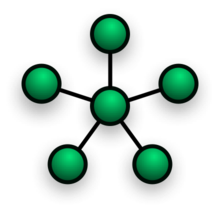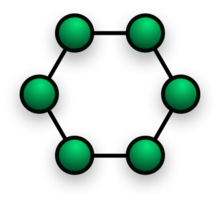JARINGAN KOMPUTER
Jaringan komputer (yang selanjutnya akan dibahas dengan menggunakan istilah
‘jaringan’) adalah sekelompok komputer otonom yang saling berhubungan antara
yang satu dengan lainnya, dan menggunakan suatu protokol komunikasi melalui
media komunikasi sehingga dapat saling berbagi dan bertukar informasi.
Pada saat ini, jaringan komputer yang paling populer adalah jaringan lokal, atau
yang lebih dikenal dengan Local Area Network (LAN). LAN adalah sekelompok
komputer yang saling berhubungan dalam area tertentu. Dengan LAN, komputerkomputer
yang terhubung dapat saling bertukar atau berbagi pakai dalam data,
perangkat pendukung (mis: printer), dan sebagainya.
Sesuai dengan perkembangan dan populernya Internet dan Intranet, jaringan
komputer dapat ditingkatkan kemampuannya untuk melakukan keperluan yang lebih
luas lagi, seperti Internet.
Jaringan komputer digunakan untuk melakukan tukar menukar atau komunikasi
data. Komponen-komponen dalam komunikasi data adalah sebagai berikut:
Komputer host
Komputer host adalah komputer yang berfungsi sebagai penyebar informasi atau
data. Host dapat berupa komputer mainframe atau komputer mini. Host yang
berupa mainframe bekerja dengan menggunakan peralatan yang disebut dengan
Front and Processor (FEP), yang merupakan komputer mini untuk mengelola
komunikasi data dari jaringan.
Komputer receiver
Komputer ini berfungsi sebagai penerima informasi
Data
Data adalah objek dari proses komunikasi yang terjadi pada jaringan.
Protokol komunikasi
Protokol komunikasi adalah peraturan-peraturan yang diterapkan dalam jaringan
dengan tujuan untuk mengatur komunikasi data. Banyaknya protokol komunikasi
menyebabkan dibutuhkannya suatu alat (tools) yang disebut dengan Gateway,
untuk menterjemahkan protokol sehingga menjadi compatible agar komunikasi
data dijaringan dapat berjalan dengan baik.
Komponen transmisi
Setelah memastikan komputer host dan receiver berjalan dengan baik, serta
memilih protokol komunikasi, dilakukan implementtasi terhadap komponen
transmisi, seperti kabel penghubung, modem, dan sebagainya.
INSTALASI JARINGAN
Agar suatu jaringan LAN atau Workgroup dapat terbentuk, selain harus memiliki
komputer Server dan Workstation, juga diperlukan perangkat keras lain yang
mendukung jaringan tersebut.
Selain hardware, sistem operasi harus diinstal agar jaringan dapat berfungsi dengan
baik. Sistem operasi yang ada antara lain Windows Server 200, Windows Server
2003, dsb. Untuk lebih jelasnya, akan dijabarkan lebih rinci di bawah ini.
Keperluan Pembuatan Jaringan
Untuk membuat suatu sistem jaringan diperlukan beberapa peralatan antara lain
sebagai berikut:
1. Sebuah komputer file-server atau yang lebih dikenal dengan server, sebagai
pusat data.
2. Komputer sebagai tempat kerja atau yang disebut dengan workstation. Jumlah
dari workstation bervariasi, muulai dari satu hingga ratusan.
3. NIC (Network Interface Card)
4. Wireless LAN
5. HUB atau Switch
6.Switch Wireless
7. Kabel UTP
8. Kabel Telepon
9. Connector RJ45 dan RJ11
10. VDSL Converter
11. UPS jika diperlukan
Peralatan jaringan tersebut merupakan kebutuhan standar untuk membuat sebuah
jaringan. Apabila jaringan ingin ditingkatkan harus dilakukan penambahan beberapa
peralatan sebagai berikut:
1. Repeater
2. Bridge
3. Router
4. Gateway
Network Interface Card (NIC)
NIC adalah kartu jaringanyang berupa papan elektronik yang akan dipasang pada
setiap komputer yang terhubung pada jaringan. Saat ini, banyak sekali jenis
kartu jaringan. Akan tetapi, ada beberapa hal yang perlu diketahui dari kartu
jaringan seperti tipe kartu, jenis protokol dan tipe kabel yang didukungnya.
Dengan perkembangan PC dan mainboard, maka tipe solt dan expansion slot pun
bermacam-macam. Akan tetapi pada modul ini cukup dibahas mengenai ISA dan
PCI. Ketika membeli komputer (khususnya komputer rakitan), tidak semua slot
terisi. Slot yang kosong dapat digunakan untuk melakukan pemasangan kartu
tambahan (mis: kartu suara, modem internal, atau kartu jaringan). Untuk
membedakan slot ISA dan PCI tidak begitu sulit. Jika casing komputer dibuka,
slot ISA biasanya berwarna hitam, sedangkan PCI berwarna putih. Untuk slot
yang bewarna coklat umumnya adalah slot AGP.
Untuk protokol jaringan, ada beberapa protokol untuk sebuah kartu jaringan
seperti Ethernet, Fast Ethernet, Token Ring, FDDI, dan ATM. Jenis Ethernet atau
Fast Ethernet sering digunakan.
Penggunaan hub dapat dikembangkan dengan mengaitkan suatu hub ke hub
lainnya. Sedangkan dari segi pengelolaannya, HUB dibagi menjadi dua jenis,
sebagai berikut:
Hub manageable
Hub jenis ini bisa dikelola dengan software yang ada di bawahnya.
Hub non-managable
Hub jenis ini pengelolaannya dilakukan secara manual.
Hub hanya memungkinkan user untuk berbagi jalur yang sama. Pada jaringan
tersebut, tiap user hanya akan mendapatkan kecepatan dari bandwith yang ada.
Misalkan jaringan yang digunakan adalah Ethernet 10 Mbps dan pada jaringan
tersebut tersambung 10 unit komputer. Jika semua komputer tersambung ke
jaringan secara bersamaan, maka bandwith yang dapat digunakan oleh masingmasing
user rata-rata adalah 1 Mbps.
Repeater
Repeater hampir sama seperti Hub. Repeater menggunakan topologi bus, yang
bekerja memperkuat sinyal agar lalu lintas data dari workstation (client) ke
server atau sebaliknya lebih cepat jika jaraknya semakin jauh. Dengan repeater
ini, jaringan dan sinyal akan semakin kuat, apalagi jika kabel yang digunakan
adalah jenis koaksial.
Bridge (jembatan)
Bridge, sesuai dengan namanya, berfungsi menghubungkan beberapa jaringan
yang terpisah, untuk jaringan yang sama maupun berbeda. Bridge memetakan
alamat jaringan dan hanya memperbolehkan lalu lintas data yang diperlukan.
Ketika menerima sebuah paket, bridge menentukan segmen tujuan dan sumber.
Jika segmennya sama, maka paket akan ditolak. Bridge juga dapat mencegah
pesan rusak agar tidak menyebar keluar dari suatu segmen.
Switch
Switch dikenal juga dengan istilah LAN switch merupakan perluasan dari bridge.
Ada dua buah arsitektur switch, sebagai berikut:
Cut through
Kelebihan dari arsitektur switch ini terletak pada kecepatan, karena pada saat
sebuah paket datang, switch hanya memperhatikan alamat tujuan sebelum
diteruskan ke segmen tujuannya.
Store and forward
Switch ini menerima dan menganalisa seluruh isi paket sebelum
meneruskannya k etujuan dan untuknya memerlukan waktu.
Keuntungan menggunakan switch adalah karena setiap segmen jaringan memiliki
bandwith 10 Mbps penuh, tidak terbagi seperti pada hub.
VDSL
Very high-bit-rate Digital Subscriber Line port merupakan alat yang berguna
sebagai converter dari label UTP ke kabel telepon. VDSL biasanya digunakan
untuk menghubungkan jaringan LAN yang jaraknya kurang dari 500 meter.
Untuk menggunakannya harus sepasang, satu dipasang di Switch atau Hub yang
berhubungan dengan server. Sedangkan yang satu lagi, dipasang di Switch atau
Hub yang berhubungan dengan client.
Wireless
Ada bermacam-macam merk dan jenis dari wireless. Beberapa notebook sudah
memasang wireless secara otomatis. Untuk memanfaatkan wireless yang sudah
ada di komputer atau memasang sebagai kartu jaringan, user harus memiliki Hub
atau Switch yang ada fasilitas wirelessnya.
Router
Cara kerja router mirip dengan switch dan bridge. Perbedaannya, router adalah
penyaring atau filter lalu lintas data. Penyaringan dilakukan dengan
menggunakan protokol tertentu. Router bukanlah perangkat fisikal, melainkan
logikal. Misalnya sebuah IP router dapat membagi jaringan menjadi beberapa
subnet sehingga hanya lalu lintas yang ditujukan untuk IP adress tertentu yang
dapat mengalir dari suatu segmen ke segmen lainnya.
Kabel jaringan
Kabel jaringan yang biasanya digunakan untuk suatu jaringan antara lain adalah
UTP (unshielded twisted pair), koaksial, dan serat optik. Sesuai dengan
perkembangan Hub, penggunaan kabel UTP lebih sering dipilih. Hal ini
dikarenakan harganya yang tidak mahal dan kemampuannya yang dapat
diandalkan.
Twisted Pair Cable (UTP)
Ada dua buah jenis kabel UTP yakni shielded dan unshielded. Shielded adalah
kabel yang memiliki selubung pembungkus. Sedangkan unshielded tidak
memiliki selubung pembungkus. Untuk koneksinya digunakan konektor RJ11
atau RJ-45.
UTP cocok untuk jaringan dengan skala dari kecil hingga besar. Dengan
menggunakan UTP, jaringan disusun berdasarkan topologi star dengan hub
sebagai pusatnya. Kabel ini umumnya lebih reliable dibandingkan dengan
kabel koaksial. Hal ini dikarenakan Hub memiliki kemampuan dara error
correction yang akan meningkatkan kecepatan transmisi.
Ada beberapa kategori dari kabel UTP. Yang paling baik adalah kategori 5.
Ada dua jenis kabel, yakni straight-through dan crossed. Kabel Straightthrough
dipakai untuk menghubungkan komputer ke Hub, komputer ke
Switch atau Switch ke Switch. Sedangkan kabel crossed digunakan untuk
menghubungkan Hub ke Hub atau Router ke Router. Untuk kabel kategori 5,
ada 8 buah kabel kecil di dalamnya yang masing-masing memiliki kode
warna. Akan tetapi hanya kabel 1,2,3,6. Walaupun demikian, ke delapan
kabel tersebut semuanya terhubung dengan jack.
Untuk kabel straight-through, kabel 1, 2, 3, dan 6 pada suatu ujung juga di
kabel 1,2,3, dan 6 pada ujung lainnya. Sedangkan untuk kabel crossed, ujung
yang satu adalah kebalikan dari ujung yang lain ( 1 menjadi 3 dan 2 menjadi
6).
Kabel koaksial
Media ini paling banyak digunakan sebagai media LAN, meski lebih mahal dan
lebih sukar dibanding dengan UTP. Kabel ini memiliki bandwith yang lebar,
oleh karena itu dapat digunakan untuk komunikasi broadband. Ada dua buah
jenis kabel koaksial, sebagai berikut:
a. Thick Coaxial
Kabel jenis ini digunakan untuk kabel pada instalasi Ethernet antar
gedung. Kabel ini dapat menjangkau jarak 500 m bahkan sampai 2500 m
dengan memasang repeater.
b. Thin Coaxial
Kabel jenis ini cocok untuk jaringan rumah atau kantor. Kabel ini mirip
seperti kabel antenna TV, harganya tidak mahal, dan mudah dipasangnya.
Untuk memasangnya, kabel ini menggunakan konektor BNC. Pada
jaringan jenis ini, untuk melakukan sambungan ke masing-masing
komputer menggunakan konektor T.
Serat Optik
Jaringan yang menggunakan F/O biasanya digunakan pada perusahaan besar.
Hal ini disebabkan karena mahal dan pemasangannya sulit. Akan tetapi,
jaringan dengan media ini memiliki kehandalan yang sangat baik dan
kecepatan yang sangat tinggi ( sekitar 100 Mbps). Keunggulan lainnya adalah
bebas dari gangguan lingkungan. Pembahasan mengenai serat optik ini akan
dibahas secara lebih rinci pada bagian selanjutnya.
Kabel Telepon
Kabel telepon adalah media yang digunakan untuk LAN beberapa tahun
terakhir. Kabel ini biasanya digunakan untuk menghubungkan jaringan antar
gedung. Kabel telepon yang digunakan untuk diluar gedung ini biasanya
dilengkapi dengan 3 kawat, dimana 2 kawat digunakan untuk penghubung
data, sementara yang satu lagi digunakan untuk mencegah agar kawat-kawat
tidak putus jika dibentang. Konektor untuk kabel telepon adalah RJ-11
Pemilihan Kabel
Pada bagian sebelumnya, telah disinggung mengenai beberapa jenis kabel jaringan.
Pada bagian ini akan dibahas cara memilih jenis kabel.
Biasanya, kabel yang sudah tertanam tidak akan diangkat atau dipindahkan selain
dalam keadaan terpaksa. Oleh karena itu, perlu dilakukan sebuah perencanaan
untuk menentukan jenis kabel yang akan digunakan. Suatu kendala akan terjadi,
jika terjadi kesalahan dalam pemilihan kabel.
Apabila akan membangun suatu jaringan, tentukan jenis dan kualitas kabel yang
baik sehingga dapat membuat jaringan berjalan dengan baik hingga 10 tahun atau
lebih. Selain jenis, masalah kecepatan dan jarak akses data perlu diperhitungkan.
Di bawah ini adalah beberapa jenis kabel jaringan, kecepatan, jarak, dan konektor
yang digunakan.
PERTANYAAN
Gambarkan sebuah arsitektur jaringan dimana gambar tersebut harus terdiri atas:
1. Komputer server
2. Komputer client
3. Hub
4. Switch
5. Access point
6. Router
7. Bridge
8. Serat Optik
9. Repeater
Gambar bisa menggunakan microsoft visio atau yang lainnya dan dikirim by email








 This section may be
This section may be 